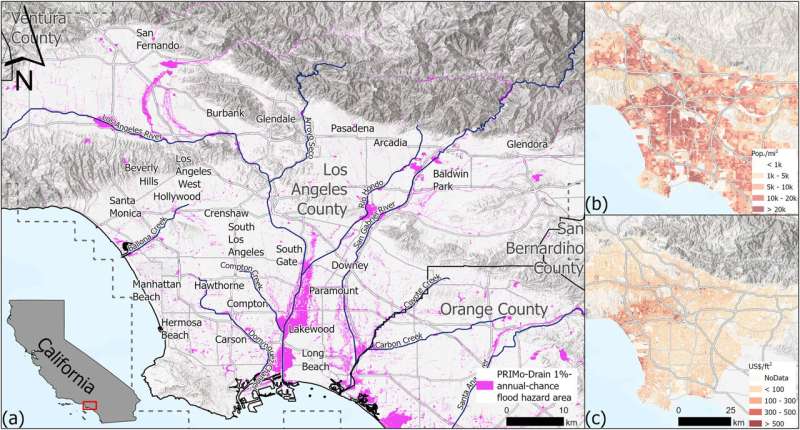This article has been reviewed according to Science X's editorial process and policies. Editors have highlighted the following attributes while ensuring the content's credibility:
fact-checked
peer-reviewed publication
trusted source
proofread
Nationwide flood models poorly reflect risks to households and properties, study finds

Government agencies, insurance companies and disaster planners rely on national flood risk models from the private sector that aren't reliable at smaller levels such as neighborhoods and individual properties, according to researchers at the University of California, Irvine.
In a paper published recently in the journal Earth's Future, experts in UC Irvine's Department of Civil and Environmental Engineering caution that relatively new, nation-scale flood data provides an inadequate representation of local topography and infrastructure, factors known to control the spread of floods in urban areas.
"In our analysis of Los Angeles County, which has a population greater than 40 U.S. states and includes over 80 separate municipalities, we found that estimates of countywide flood exposure from the nationwide data are actually similar to what we find with our more detailed models. However, predictions of which communities and properties are at risk are markedly different," said senior author Brett Sanders, UC Irvine Chancellor's Professor of civil and environmental engineering and professor of urban planning and public policy.
"In addition, these differences between models imply a disparity in exposure inequality across social groups, including Black, white and disadvantaged sectors of society," he said. "Exposure hot spots and social inequalities are key factors that inform urban flood risk planning, and overreliance on this data could lead to maladaptation of protective measures."
Sanders and colleagues at UC Irvine and the University of Miami developed a more detailed model named PRIMo-Drain, which they said improves the accuracy of flood inundation predictions by including fine-resolution topographic data; information about levees and channel conditions; and particulars about stormwater infrastructure such as culverts, subsurface pipes and street drains.
"Comparing exposure assessments with nationwide data models versus PRIMo-Drain, we found that city-by-city estimates differed by a factor of 10," Sanders said. "Additionally, we found that there is only a 1-in-4 chance that the nationwide data and UC Irvine data agree on which properties are at risk of more than a foot of flooding from an extreme event."

Federal programs to map flood hazards across the U.S. have been unable to keep up with changes in land use and climate, he said, while governments at all levels and the insurance industry urgently need this information to manage risks.
"New, nationwide data sources have emerged from the private sector to meet this demand, but unfortunately, these models are missing the level of detail required to map flood risks accurately in urban areas," Sanders said. "New models would benefit from the inclusion of more complete representations of drainage infrastructure such as levees, flood channels, culverts and storm drains, as well as bathymetric and hydrologic data."
Sanders and colleagues also point to a new strategy for better nationwide data.
"Collaborative flood modeling, with scientists and engineers using cutting-edge regional models in coordination with stakeholders, could create an economy of scale that lowers the overhead necessary to cover less wealthy and smaller communities while increasing flood awareness and preparedness across impacted populations," Sanders said.
"Flood risk awareness is critical for participation in flood insurance programs; more accurate data will help insurance companies identify insurable properties; and property owners will be better informed about the cost-effectiveness of flood-proofing."
Joining Sanders on this project were Jochen Schubert, a UC Irvine research specialist in civil and environmental engineering, and Katharine Mach of the University of Miami.
More information: Jochen E. Schubert et al, National‐Scale Flood Hazard Data Unfit for Urban Risk Management, Earth's Future (2024). DOI: 10.1029/2024EF004549
Journal information: Earth's Future
Provided by University of California, Irvine



















